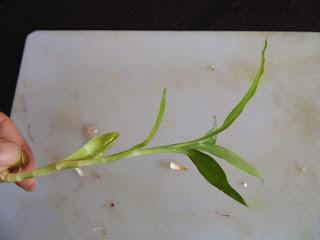Spinach
is a cool season leafy vegetable. Known
for lush green foliage spinach is rich in iron, vitamins and anti
oxidants. Spinach crop can be harvested
after 6-8 weeks from planting. In warm climate spinach tends to produce seeds
rather than growing the foliage. So harvest it at right time. It is called as 'Palak' in Hindi. Spinach can be
grown in containers at home, follow below tips for success.
Propagation
Spinach is propagated
from seeds. Prepare soil enriched with garden compost and sow seeds ½ inch deep
and 1 inch apart. Water the soil without affecting seeds. Seeds germinate in a
week. Then thin out the weakest seedlings and create 3-4 inches of space
between two consecutive seedlings. This increases air circulation around the
crop and minimizes the chances of any fungal attack.
Container
Prefer a tray to
regular pots or container to propagate spinach, tray being 3-4 feet long
provides a large surface area for sowing more number of seeds. Planting tray
should have sufficient number of holes at bottom. You can put small pieces of
bricks or stones over the holes to help with drainage.
Soil
Spinach grows in any
type of well drained soil. However loamy soil is ideal. Soil should be loose
too so that spinach seedlings could establish roots easily and quickly. Add a fine
layer of garden compost to the soil. It will provide nutrients to the plants.
Sun/Temperature
Spinach thrives in full
direct sunlight. It should get minimum 5 hrs of sunlight. So place your
container where it gets that much light like east facing window or balcony.
Partial shade is beneficial for spinach.
Watering
Spinach is a humidity
loving plant. Mulch the soil using dried leaves, straws etc to retain moisture
around the plant. Water spinach regularly. Keep soil moist.
Fertilizer
Spinach doesn’t have
feeding requirements. Good quality compost works well as fertilizer. If you
want feed the plant with nitrogen based fertilizer as it promotes foliage
growth on the plant.
Harvesting
Start harvesting crop
after 6-8 weeks of planting. Cut off outer leaves which are 3-4 inches long. It
will encourage more growth on the plant and ultimately results in more foliage
to harvest. Remember to harvest the crop completely before plant blots and
produces seeds. (Generally when temperature rises the plant tends to flower and
fruit due to increased temperature and stops producing more leaves)
Caring
Spinach plant can be
attacked by mealy bugs, aphid and slugs. So inspect the crop regularly and
treat it on time.


























